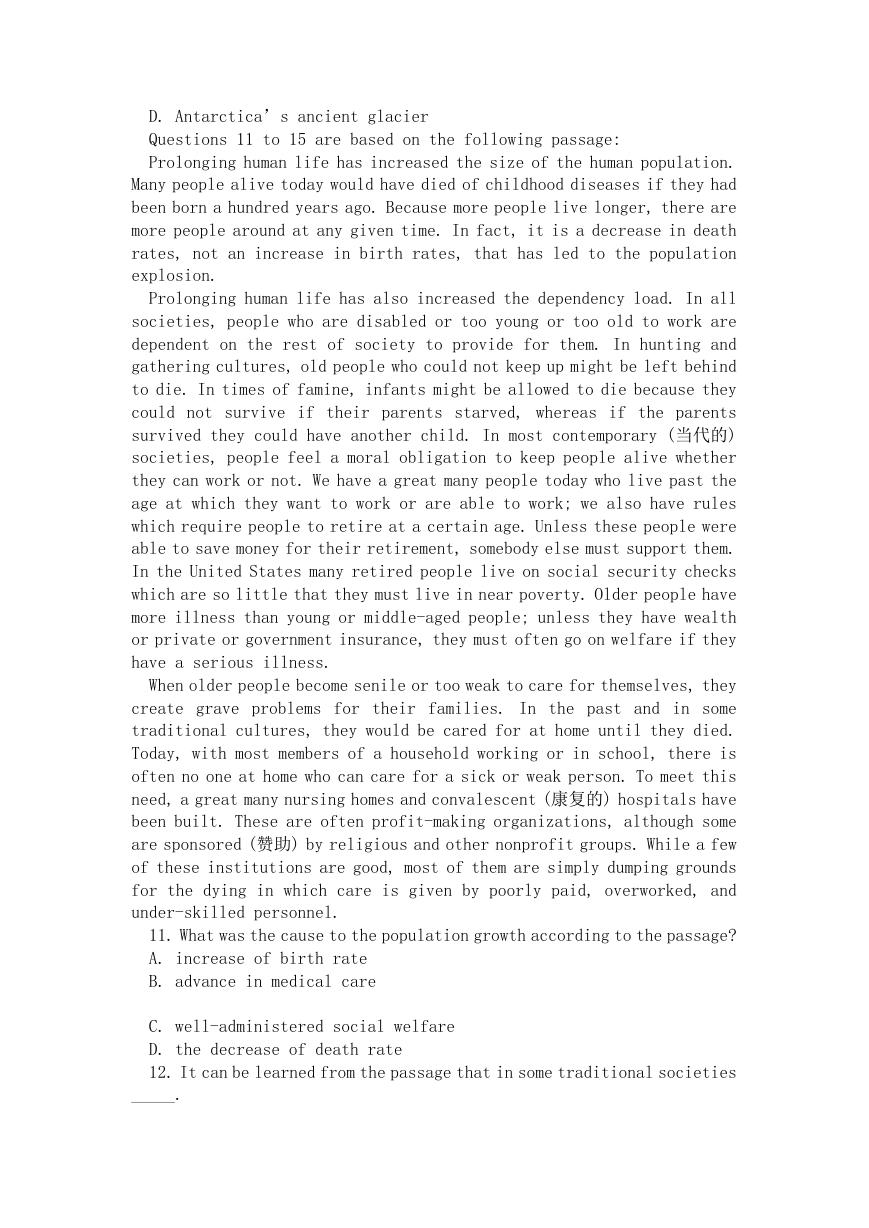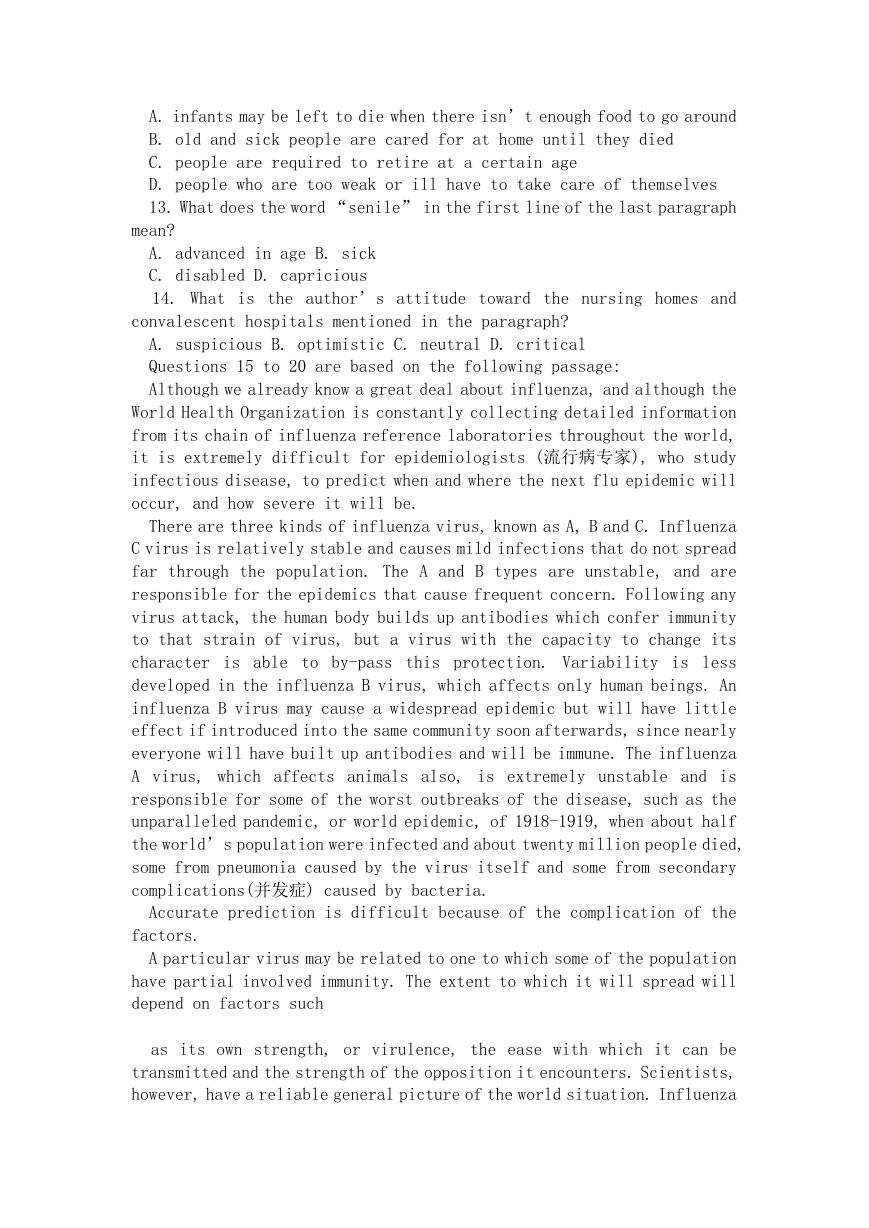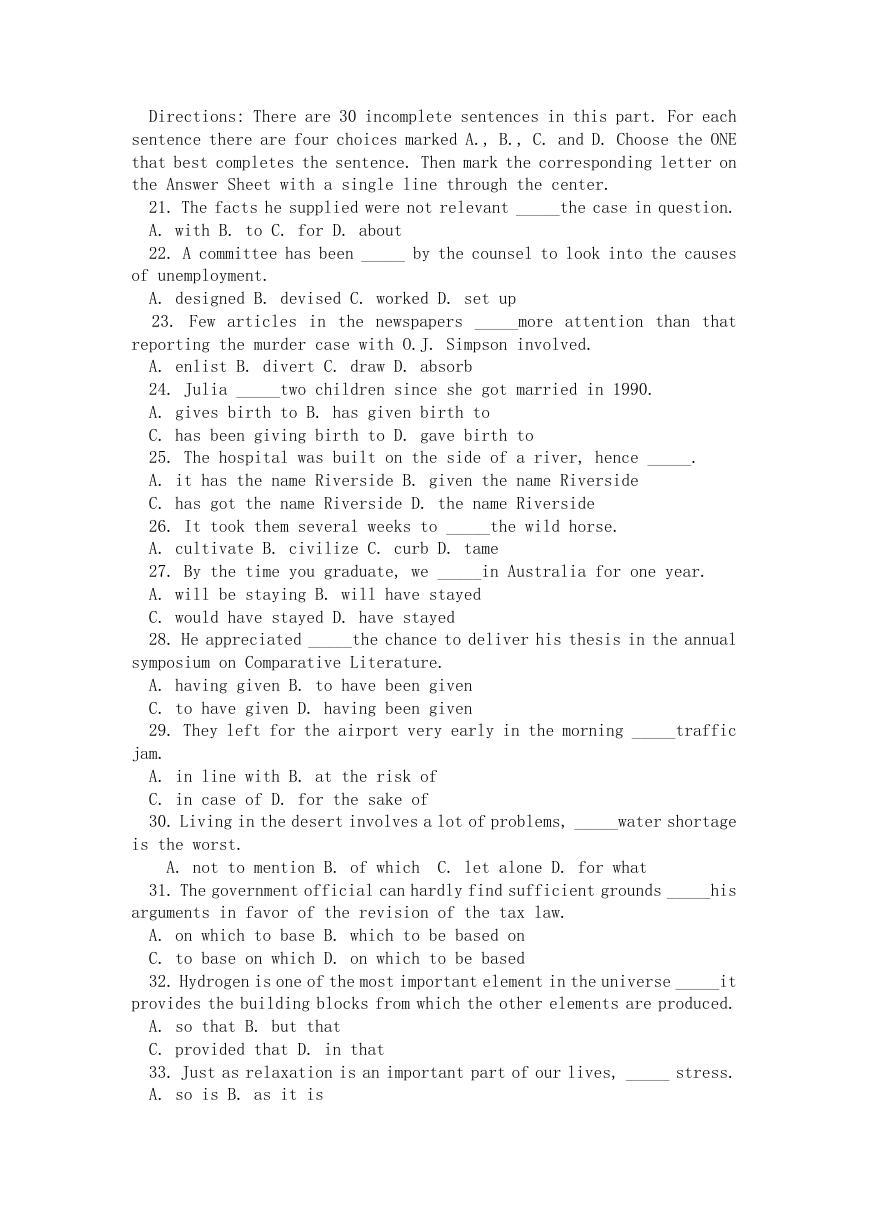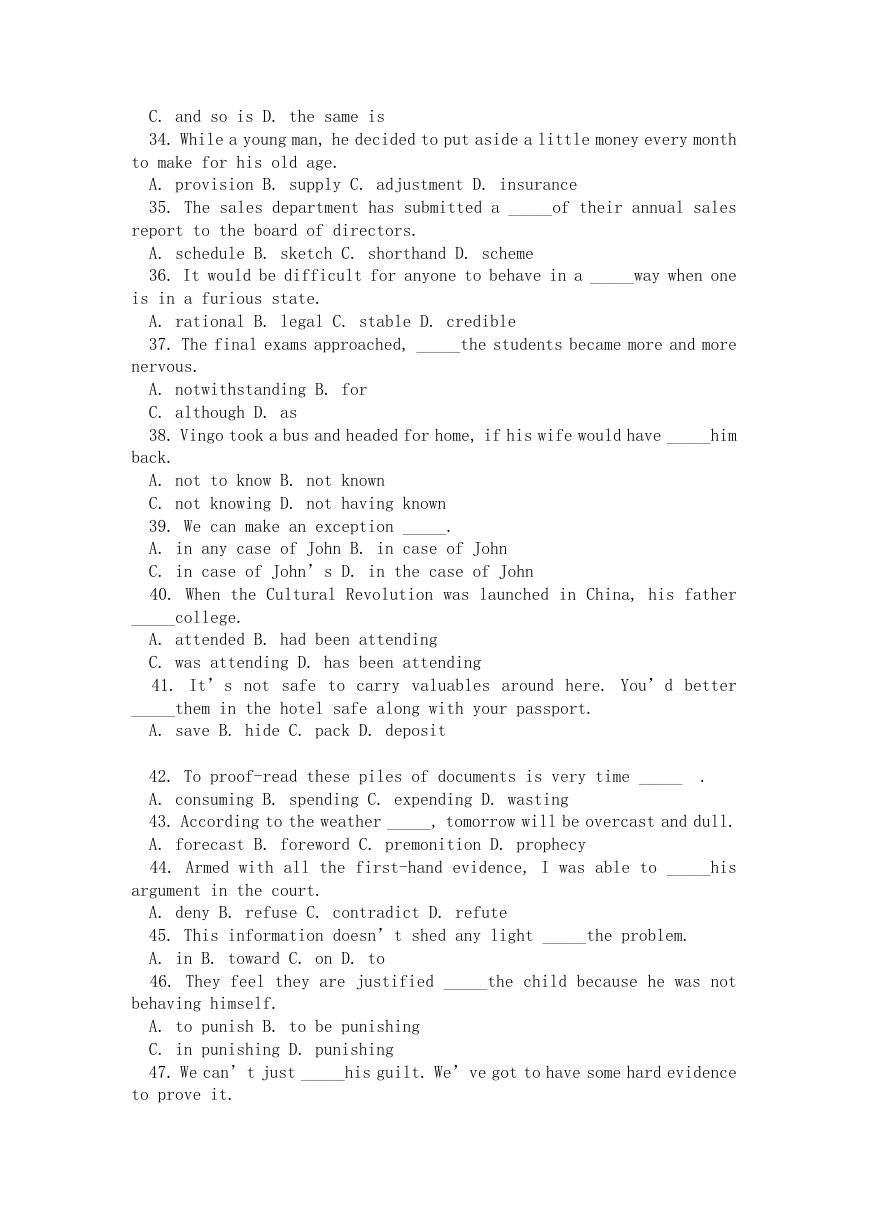2013 年中国工商银行招聘考试笔试英语真题及答案
Part I Reading Comprehension
Directions: There are 4 reading passages in this part. Each passage is
followed by some questions or unfinished statements. For each of them
there are four choices marked A., B., C. and D. You should decide on the
best choice and mark the corresponding letter on the Answer Sheet with
a single line through the center. Questions 1 to 5 are based on the
following passage:
If the salinity of ocean water is analyzed, it is found to vary only
slightly from place to place. Nevertheless, some of these small changes
are important. There are three basic processes that cause a change in
oceanic salinity. One of these is the subtraction of water from the ocean
by means of evaporation—conversion of liquid water to water vapor. In
this manner, the salinity is increased, since the salts stay behind. If
this is carried to the extreme, of course, white crystals of salt would
be left behind; this, by the way, is how much of the table salt we use
is actually obtained.
The opposite of evaporation is precipitation, such as rain, by which
water is added to the ocean. Here the ocean is being diluted so that the
salinity is decreased. This may occur in areas of high rainfall or in
coastal regions where rivers flow into the ocean. Thus salinity may be
increased by the subtraction of water by evaporation, or decreased by the
addition of fresh water by precipitation or runoff. Normally, in tropical
regions where the sun is very strong, the ocean salinity is somewhat higher
than it is in other parts of the world where there is not as much
evaporation. Similarly, in coastal regions where rivers dilute the sea,
salinity is somewhat lower than in other oceanic areas.
A third process by which salinity may be altered is associated with the
formation and melting of sea ice. When seawater is frozen, the dissolved
materials are left behind. In this manner, seawater directly beneath
freshly formed sea ice has a higher salinity than it did before the ice
appeared. Of course, when this ice melts, it well tend to decrease the
salinity of the surrounding water.
In the Weddell Sea, off Antarctica, the densest water in the oceans is
formed as a result of this freezing process, which increases the salinity
of cold water. This heavy water sinks and is found in the deeper portions
of oceans of the world.
1. What is the main topic of the passage?
A. Where do we get our table salt?
B. Oceanic salinity in tropical regions
C. Three basic processes that alter oceanic salinity
�
D. Variations of salinity in different parts of the ocean
2. According to the author, the oceanic salinity is usually lower in
_____.
A. tropical regions
B. coastal regions
C. places in which warm currents and cold currents meet
D. the Antarctica
3. All of the following are processes that decrease ocean salinity
except _____.
A. precipitation B. runoff C. melting D. evaporation
4. What does the word “subtraction" in the fourth line of the first
paragraph mean?
A. reduction B. influx C. transformation D. freezing
5. Which of the following is NOT a result of the formation of ice in
oceans?
A. The surrounding water sinks.
B. The water becomes denser.
C. Water salinity decreases.
D. The surrounding water becomes colder.
Questions 6 to 10 are based on the following passage:
More than a century ago, the relationship between glacial ice and the
amount of water in the ocean basins was first seen. When the great ice
sheet covered vast land areas, the sea level was lowered because the normal
return of water from land to the ocean was reduced. As a result, the sea
level rose as Ice Age glaciers melted allowing the melted waters to flow
into the ocean. If all the glacial ice on the surface of the earth today
should melt, the sea level might rise by more than 150 feet. Shoreline
variations are also produced through elevation or depression of the land.
During times of glacier formations the great weight of the ice slowly
depressed the earth’s crust. Removal of the weight through glacier
melting allowed the slow return of the crust to its former position.
Changes in the Great Ice climates from cool and wet to warm and dry produced
climate changes far from the glaciated area. For example, at times of
cool-wet glacial climates, levels of inland lakes rose, in contrast to
the depression of sea level. During the warm-dry interglacial climates,
lake levels were lowered. The ancient lake Bonneville, largest of the
glacial lakes in Western United States, once covered more than 20,000
square miles. It had a maximum depth of more than 1,000 feet. Great Salt
Lake in Utah is the shrunken remnant of this once large lake.
Although the first time that early man walked on the earth is uncertain,
he is largely a product of the Great Ice Age. Present information shows
that during this time he evolved rapidly both physically and culturally.
His most primitive tools
�
and skeletal remains have been found in some of the oldest deposits
contemporary with the Great Ice Age in Africa, Asia and Europe. These are
often associated with remains of extinct animals. With the disappearance
of the great ice sheets, the Bronze and Iron Age cultures evolved. About
this time many animals suited to cooler climates died.
Although much remains to be learned, the story of the Great Ice Age is
being unfolded through the efforts of specialists in many fields.
Recording field observation, new theories and methods, and worldwide
studies of existing glaciers are bringing a clearer understanding of the
Great Ice Age.
6. Which of the following is NOT implied in the passage?
A. Man has a lot more to learn about the Great Ice Age.
B. The art of making tools was instrumental in bringing about the
evolution of human brain.
C. Many species were not suited to the warmer climates of the Bronze
and Iron Age.
D. The relationship between glacial ice and the amount of water in the
ocean basins was not seen until more than a hundred years ago.
7. According to the article, which of the following will induce the
depression of sea level?
A. formation of great masses of ice sheet on the land
B. precipitation
C. shoreline variations
D. the advent of warm-dry interglacial climates
8. Why does the author cite the example of the Great Salt Lake in Utah?
A. to show that it is a lake created in the Great Ice Age
B. to show that it once was the largest lake in the United States
C. to show that it evolved from the Bronze and Iron Age
D. to show that it is what remained of the once large lake Bonneville
9. Which of the following can be learned about early man based on the
information provided in the passage?
A. The exact time of his appearance on the Earth is uncertain.
B. He evolved rapidly physically and culturally during the Bronze and
Iron Age.
C. The ability to make primitive tools distinguished man from other
animals.
D. Early man lived mainly on animals hunted.
10. The best source of information about the Great Ice Age is obtained
from _____.
A. rock formations
B. fossil remains
C. primitive tools used by early man
�
D. Antarctica’s ancient glacier
Questions 11 to 15 are based on the following passage:
Prolonging human life has increased the size of the human population.
Many people alive today would have died of childhood diseases if they had
been born a hundred years ago. Because more people live longer, there are
more people around at any given time. In fact, it is a decrease in death
rates, not an increase in birth rates, that has led to the population
explosion.
Prolonging human life has also increased the dependency load. In all
societies, people who are disabled or too young or too old to work are
dependent on the rest of society to provide for them. In hunting and
gathering cultures, old people who could not keep up might be left behind
to die. In times of famine, infants might be allowed to die because they
could not survive if their parents starved, whereas if the parents
survived they could have another child. In most contemporary (当代的)
societies, people feel a moral obligation to keep people alive whether
they can work or not. We have a great many people today who live past the
age at which they want to work or are able to work; we also have rules
which require people to retire at a certain age. Unless these people were
able to save money for their retirement, somebody else must support them.
In the United States many retired people live on social security checks
which are so little that they must live in near poverty. Older people have
more illness than young or middle-aged people; unless they have wealth
or private or government insurance, they must often go on welfare if they
have a serious illness.
When older people become senile or too weak to care for themselves, they
create grave problems for their families. In the past and in some
traditional cultures, they would be cared for at home until they died.
Today, with most members of a household working or in school, there is
often no one at home who can care for a sick or weak person. To meet this
need, a great many nursing homes and convalescent (康复的) hospitals have
been built. These are often profit-making organizations, although some
are sponsored (赞助) by religious and other nonprofit groups. While a few
of these institutions are good, most of them are simply dumping grounds
for the dying in which care is given by poorly paid, overworked, and
under-skilled personnel.
11. What was the cause to the population growth according to the passage?
A. increase of birth rate
B. advance in medical care
C. well-administered social welfare
D. the decrease of death rate
12. It can be learned from the passage that in some traditional societies
_____.
�
A. infants may be left to die when there isn’t enough food to go around
B. old and sick people are cared for at home until they died
C. people are required to retire at a certain age
D. people who are too weak or ill have to take care of themselves
13. What does the word “senile” in the first line of the last paragraph
mean?
A. advanced in age B. sick
C. disabled D. capricious
14. What is the author’s attitude toward the nursing homes and
convalescent hospitals mentioned in the paragraph?
A. suspicious B. optimistic C. neutral D. critical
Questions 15 to 20 are based on the following passage:
Although we already know a great deal about influenza, and although the
World Health Organization is constantly collecting detailed information
from its chain of influenza reference laboratories throughout the world,
it is extremely difficult for epidemiologists (流行病专家), who study
infectious disease, to predict when and where the next flu epidemic will
occur, and how severe it will be.
There are three kinds of influenza virus, known as A, B and C. Influenza
C virus is relatively stable and causes mild infections that do not spread
far through the population. The A and B types are unstable, and are
responsible for the epidemics that cause frequent concern. Following any
virus attack, the human body builds up antibodies which confer immunity
to that strain of virus, but a virus with the capacity to change its
character is able to by-pass this protection. Variability is less
developed in the influenza B virus, which affects only human beings. An
influenza B virus may cause a widespread epidemic but will have little
effect if introduced into the same community soon afterwards, since nearly
everyone will have built up antibodies and will be immune. The influenza
A virus, which affects animals also, is extremely unstable and is
responsible for some of the worst outbreaks of the disease, such as the
unparalleled pandemic, or world epidemic, of 1918-1919, when about half
the world’s population were infected and about twenty million people died,
some from pneumonia caused by the virus itself and some from secondary
complications(并发症) caused by bacteria.
Accurate prediction is difficult because of the complication of the
factors.
A particular virus may be related to one to which some of the population
have partial involved immunity. The extent to which it will spread will
depend on factors such
as its own strength, or virulence, the ease with which it can be
transmitted and the strength of the opposition it encounters. Scientists,
however, have a reliable general picture of the world situation. Influenza
�
A attacks us in waves every two or three years, while influenza B, which
travels more slowly, launches its main assaults every three to six years.
The outbreaks vary from isolated cases to epidemics involving a tenth or
more of the population. We may confidently prophesy that sooner or later
large numbers of people will be feeling the unpleasant effects of some
kind of influenza virus.
15. Which of the following is the most appropriate title for the passage?
A. Symptoms of Influenza
B. Man Versus Virus
C. World Health Organization: Forefront against Influenza Virus
D. Variability of Influenza Virus
16. According to the author, which of the following is NOT true about
influenza?
A. Man has obtained a great deal of knowledge about influenza.
B. The occurrence of influenza is still unpredictable.
C. Influenza is being studied extensively and systematically in many
countries in the world under the guidance of World Health Organization.
D. No reliable treatment of influenza has yet been found.
17. What does the author say about the influenza B virus?
A. B virus is relatively stable and causes mild infections that do not
spread far through the population.
B. B virus is unstable, and is responsible for the epidemics that cause
frequent concern.
C. B virus is extremely unstable and is responsible for some of the worst
outbreaks of the disease.
D. B virus has a very developed variability, and it affects only human
beings.
18. Which of the following is the most dangerous virus according to the
passage?
A. influenza A virus
B. influenza B virus
C. influenza C virus
D. it cannot be determined by the information provided
19. What does the word “assault” in the eighth line of the last
paragraph mean?
A. influence B. attack C. symptom D. damage
20. Which of the following is NOT mentioned as a factor contributing
to the extent to which a virus spreads?
A. the strength of the virus
B. the strength of the opposition the virus encounters
C. the ease with which the virus can be transmitted
D. the immunity the virus can induce
Part II Vocabulary and Structure
�
Directions: There are 30 incomplete sentences in this part. For each
sentence there are four choices marked A., B., C. and D. Choose the ONE
that best completes the sentence. Then mark the corresponding letter on
the Answer Sheet with a single line through the center.
21. The facts he supplied were not relevant _____the case in question.
A. with B. to C. for D. about
22. A committee has been _____ by the counsel to look into the causes
of unemployment.
A. designed B. devised C. worked D. set up
23. Few articles in the newspapers _____more attention than that
reporting the murder case with O.J. Simpson involved.
A. enlist B. divert C. draw D. absorb
24. Julia _____two children since she got married in 1990.
A. gives birth to B. has given birth to
C. has been giving birth to D. gave birth to
25. The hospital was built on the side of a river, hence _____.
A. it has the name Riverside B. given the name Riverside
C. has got the name Riverside D. the name Riverside
26. It took them several weeks to _____the wild horse.
A. cultivate B. civilize C. curb D. tame
27. By the time you graduate, we _____in Australia for one year.
A. will be staying B. will have stayed
C. would have stayed D. have stayed
28. He appreciated _____the chance to deliver his thesis in the annual
symposium on Comparative Literature.
A. having given B. to have been given
C. to have given D. having been given
29. They left for the airport very early in the morning _____traffic
jam.
A. in line with B. at the risk of
C. in case of D. for the sake of
30. Living in the desert involves a lot of problems, _____water shortage
is the worst.
A. not to mention B. of which
C. let alone D. for what
31. The government official can hardly find sufficient grounds _____his
arguments in favor of the revision of the tax law.
A. on which to base B. which to be based on
C. to base on which D. on which to be based
32. Hydrogen is one of the most important element in the universe _____it
provides the building blocks from which the other elements are produced.
A. so that B. but that
C. provided that D. in that
33. Just as relaxation is an important part of our lives, _____ stress.
A. so is B. as it is
�
C. and so is D. the same is
34. While a young man, he decided to put aside a little money every month
to make for his old age.
A. provision B. supply C. adjustment D. insurance
35. The sales department has submitted a _____of their annual sales
report to the board of directors.
A. schedule B. sketch C. shorthand D. scheme
36. It would be difficult for anyone to behave in a _____way when one
is in a furious state.
A. rational B. legal C. stable D. credible
37. The final exams approached, _____the students became more and more
nervous.
A. notwithstanding B. for
C. although D. as
38. Vingo took a bus and headed for home, if his wife would have _____him
back.
A. not to know B. not known
C. not knowing D. not having known
39. We can make an exception _____.
A. in any case of John B. in case of John
C. in case of John’s D. in the case of John
40. When the Cultural Revolution was launched in China, his father
_____college.
A. attended B. had been attending
C. was attending D. has been attending
41. It’s not safe to carry valuables around here. You’d better
_____them in the hotel safe along with your passport.
A. save B. hide C. pack D. deposit
42. To proof-read these piles of documents is very time _____
A. consuming B. spending C. expending D. wasting
43. According to the weather _____, tomorrow will be overcast and dull.
A. forecast B. foreword C. premonition D. prophecy
44. Armed with all the first-hand evidence, I was able to _____his
.
argument in the court.
A. deny B. refuse C. contradict D. refute
45. This information doesn’t shed any light _____the problem.
A. in B. toward C. on D. to
46. They feel they are justified _____the child because he was not
behaving himself.
A. to punish B. to be punishing
C. in punishing D. punishing
47. We can’t just _____his guilt. We’ve got to have some hard evidence
to prove it.
�
















 2023年江西萍乡中考道德与法治真题及答案.doc
2023年江西萍乡中考道德与法治真题及答案.doc 2012年重庆南川中考生物真题及答案.doc
2012年重庆南川中考生物真题及答案.doc 2013年江西师范大学地理学综合及文艺理论基础考研真题.doc
2013年江西师范大学地理学综合及文艺理论基础考研真题.doc 2020年四川甘孜小升初语文真题及答案I卷.doc
2020年四川甘孜小升初语文真题及答案I卷.doc 2020年注册岩土工程师专业基础考试真题及答案.doc
2020年注册岩土工程师专业基础考试真题及答案.doc 2023-2024学年福建省厦门市九年级上学期数学月考试题及答案.doc
2023-2024学年福建省厦门市九年级上学期数学月考试题及答案.doc 2021-2022学年辽宁省沈阳市大东区九年级上学期语文期末试题及答案.doc
2021-2022学年辽宁省沈阳市大东区九年级上学期语文期末试题及答案.doc 2022-2023学年北京东城区初三第一学期物理期末试卷及答案.doc
2022-2023学年北京东城区初三第一学期物理期末试卷及答案.doc 2018上半年江西教师资格初中地理学科知识与教学能力真题及答案.doc
2018上半年江西教师资格初中地理学科知识与教学能力真题及答案.doc 2012年河北国家公务员申论考试真题及答案-省级.doc
2012年河北国家公务员申论考试真题及答案-省级.doc 2020-2021学年江苏省扬州市江都区邵樊片九年级上学期数学第一次质量检测试题及答案.doc
2020-2021学年江苏省扬州市江都区邵樊片九年级上学期数学第一次质量检测试题及答案.doc 2022下半年黑龙江教师资格证中学综合素质真题及答案.doc
2022下半年黑龙江教师资格证中学综合素质真题及答案.doc